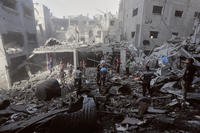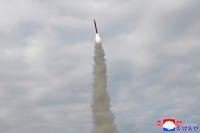U.S. Army officials tested procedures for sterilized trainee transport Tuesday by moving hundreds of new soldiers in two caravans of disinfected buses to advanced individual training bases in an effort to protect the service's training installations from exposure to the novel coronavirus.
About 800 soldiers traveled in 32 clean buses from Basic Combat Training (BCT) at Fort Jackson, South Carolina, to Fort Lee, Virginia, while another group of sterile buses transported new soldiers from Fort Sill, Oklahoma, to Fort Sam Houston in San Antonio, Texas.
Transporting hundreds of new soldiers each week between training bases was routine until the COVID-19 pandemic exploded across the country.
Now, the Army's Center for Initial Military Training (CIMT) has had to charter special buses, wipe down every surface that people come in contact with, and travel without stopping to keep trainees in a protective bubble, Maj. Gen. Lonnie Hibbard, commander of CIMT, told Military.com on Wednesday.
Related: Recruits Who Carried COVID-19 to Boot Camp Had Passed Temp Checks, Screenings
"We did two tests yesterday, so we not only did Fort Jackson to Fort Lee with my logisticians, we also went from Fort Sill to San Antonio," Hibbard said, adding that the buses that travel to Fort Sam Houston carried Army medics.
"It was our test-run of it all just to make sure we could do it ... and we are making sure all the procedures were correct," he said.
CIMT officials could not provide details on how many trainees traveled from Sill to Sam Houston by press time.
The effort called for contracting buses with restrooms on board to avoid stops along the way, Hibbard said.
To practice social distancing, the Army put only 25 soldiers on each of the 50-passenger buses from Jackson, so it required twice as many vehicles for each transport, Hibbard said.
"Even though they came from a protected bubble, they were still abiding by the same social-distancing rules," he said. "We screened the drivers, we disinfected the buses ... we screened all the trainees before they got on the bus. In addition to the questions about, ‘how are you feeling,’ we took their temperatures, and we recorded it on a form that every trainee had. They signed it, and their drill sergeant signed it. We put them on the bus with their kit and then moved them out without stopping."
The test runs were the latest measures the Army has launched to keep from shutting down its initial-entry training operation as COVID-19 threatens to paralyze the United States for at least several more months.
"The generation of soldiers for our Army is critical because the challenge is we don't know how long this is going to take," Hibbard said.
He said he has confidence in the extensive amount of safeguards already in place but conceded that "it's a matter of time. COVID will get into the training base."
An Army spokeswoman declined to say whether there had been any positive cases of COVID-19 at initial military training, citing DoD guidance prohibiting units of commands from releasing aggregate case numbers.
To control the possible spread of the highly contagious virus, CIMT has completely revamped its procedures for processing, housing and training new soldiers.
Trainees are screened 14 days out and then 96 hours, 72 hours and 24 hours from shipping to BCT. They then have their temperatures taken and are screened by medical personnel at military entrance processing stations, or MEPS.
"They climb on disinfected buses that the MEPS contracted, using social distancing rules by using twice the number of buses than normal, and they move from the MEPS to the reception battalions," Hibbard said, describing how they are screened again upon arrival at the Army's initial training bases.
The service has also cut the number of trainees it is shipping each week from about 1,200 to about 600 per week to allow trainees to be spaced farther apart in the barracks.
"At Fort Jackson, our barracks are 60-man, open-bay barracks ... and like this week, we only put 22 per barracks room, so that we can now go every other bunk top to bottom to ensure we are maximizing social distancing in the barracks," Hibbard said. "In the event we were to get a positive COVID-19 case now in a platoon, we are only isolating with the minimum number of people."
Army initial training centers have also started a 14-day "controlled monitoring" phase of BCT, where groups of up to 30 new trainees are kept separate from other trainees in case any of them develop COVID-19 symptoms in that time period, Hibbard said.
"So, if somebody does happen to become symptomatic ... we immediately move them to quarantine," he said. "The goal is, once that 14-day controlled monitoring is complete, they enter now into the bubble of basic training, where we are pretty well assured that they are COVID-19 free."
During the 14-day period, trainees stay with the same three drill sergeants and focus on fitness training and classroom-style training that is traditionally spread throughout BCT, Hibbard said.
"So that way, we are keeping them mentally and physically engaged. They still have leadership, but we are minimizing risk to the lowest possible level," he added.
-- Matthew Cox can be reached at matthew.cox@military.com.
Read More: Marine Corps Closes Parris Island Boot Camp to New Recruits as COVID-19 Cases Spread












